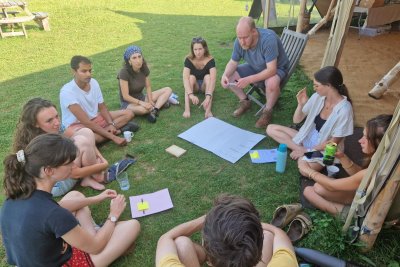 Credit: Pixabay
Credit: Pixabay
How can public and private finance support an agroecological farming future?
To kick start our work on innovative finance, James Woodward and Vicki Hird at Sustain take a brief look into some of the ways in which public and private finance can support farmers in transitioning to whole farm agroecology systems.
Food and Agriculture Organisation - The 10 Elements of Agroecology
We know we need to manage the land differently given the challenges ahead not least in tackling climate and nature issues and ensuring resilience in our food supply. One key barrier to transforming our farming in the UK to more sustainable and resilient systems is access to finance and capital.
This is both for established farms in making changes that can involve risk, but also communities and new entrants aiming to get into farming. Equally, there is an issue with farm business debt being tied up in the conventional system. For all farms but particularly, small and medium sized farms looking for a different way to manage the land, these factors can be a big constraint.
We are seeing a major shift in the way public finance in farming and food production is being designed and prioritised. These changes will create issues for many farmers as the traditional subsidy scheme is gradually withdrawn by 2027. In England, the Environmental Land Management (ELM) schemes will be a shift away from area-based payments (i.e. largely being paid according to land ownership) and towards delivering public goods (such as biodiversity, natural flood management, and soil carbon sequestration). These are seen as public goods, where there is no private market. There may be tools to blend this public finance with other, possibly private sources but details are thin on this so far. Funding for vital associated research into agro-ecology we know is also inadequate though some farmers are getting on with innovative farmer led research anyway.
Similarly to public finance, more investors and investment funds operate according to environmental, social and good governance (ESG) standards, which may help drive up standards.
Critically, we are also seeing more private investment, whether from individuals or funds, looking towards impact investing – a step further than ESG. This is based on direct investment in businesses or organisations that aim to deliver greater societal and environmental benefits, with returns for the investor. This type of investment is regularly linked to delivering on UN Sustainability Goals and Human Rights. Can such investment help drive changes in the food system?
The need for innovative finance should not override the need to better ensure, via incentives, regulation and enforcement, that the private marketplace for land-based goods pays and deals fairly with producers. There is a great imbalance of power in the food system where a handful of buyers can dictate the deal and prices, which has consistently resulted in low farm incomes. This creates significant barriers for farmers wanting to change and improve sustainability. We cover these critical issues elsewhere.
We wanted to look in more detail at opportunities for driving change via innovative finance. We touch below on some examples we have found so far which aim to try and do things better (and this is by no means a complete list):
The Perennial Fund (USA-based)
Based in the USA, Mad Agriculture launched their newly awaited Perennial Fund in the autumn of 2020. Their aim is to bring together private investment and use it as ‘transition finance’ for supporting a shift to organic models of farming. These operating loans are supported with business planning and market access advice to help conventional farmers be successful in their shift to an agroecological farming system. There is a three-year grace period and farmers only pay back on their loan when making a profit, meaning this is a ‘farmer-first term’ approach. We could seek to establish a similar approach here in the UK, potentially using a blend of public and private money.
Environmental Land Management (ELM)
The UK’s long awaited change in agri-environmental farming policy is expected to see a move towards farmers delivering ‘public money for public goods’. This approach to farm subsidy will be designed to deliver on a range of outcomes, from soil health and biological pest management, to landscape-scale nature recovery projects. Other parts of the new taxpayer funded programme may also be vital including the productivity and animal health and welfare grants.
Feed-in tariff
A recent blog by Chris Blake at the Food, Farming and Countryside Commission discussed the idea of a feed-in tariff based on the model used by the electricity market. The proposition is that a levy on luxury food items could create a public income stream that is used to subsidise farmers in providing products for local supply chains, if they meet environmental standards. This would encourage farmers to invest in more agroecological systems and in developing greater local food systems.
Triodos Bank UK Crowdfunding
This crowdfunding platform allows private investors to invest in ethical and sustainable businesses. This could include investing in farmers looking to base their model on agroecology approaches. This impact investment mechanism aims high on positive social and environmental outcomes, with investors still getting a return.
UK Shared Prosperity Fund
The replacement of the EU structural funds, UKSPF will provide regional investment from public money. One conduit for delivering this money could be through Local Enterprise Partnerships (LEPs) and ideally other bodies would be able to access this fund. They could support local food systems through infrastructure projects (such as part processing, meat preparation, storage, milling etc.) and start-up funding for food businesses (e.g. butchers, grocers, farm shops), or by supporting farm investing into on-farm food processing facilities. The local food approach could provide more jobs in rural areas, helping to revive communities.
National Agroecology Development Bank (NADB)
This could bring together long-term investors to fund farmers in transitioning to agroecological farming. The NADB would be a public bank in the sense that it would be a not-for-profit business. It would raise money from long-term investors by selling its shares and bonds and by creating new money in the form of loans, in the normal way that banks are legally empowered to do. It would operate as a wholesale bank, backing other retail banks, especially regional and mutual’s, to support the investments needed to fund the ten-year for agroecology plan. A good existing model would be the AgroEcology Fund.
Cooperative farming models
Farm cooperatives are based around joint marketing and collective buying. This increases farmers bargaining power and can help them access costly equipment, technology and resources, as well as gaining a fairer price for their produce and a wider consumer base. Initial investment is needed to cover costs and risks, but Co-operatives UK can provide support.
The Real Farming Trust also provides financial support through their 'Loans for Enlightened Agriculture (LEAP).' This loan system aims to put people and the biosphere ar the heart of the food system in the UK. Further to this, their are other collaborative models such as Community Supported Agriculture, where individuals invest in local production.
Ecological Land Cooperative
This is a land donation model that asks for finance, community investment, and land investments to support the development of affordable, low impact, smallholdings for agroecological agriculture. The high costs of rural housing is also a barrier they aim to overcome: the average house price in rural areas has more than doubled over the past decade to over £250,000, while the average salary is £21,000.
Black Farmer Fund (USA-based)
This is a recently launched community-based fund that supports black food system entrepreneurs in the US state of New York. Alongside finance, they also invest in financial education and literacy. An aim of the fund is to increase buisness diversity and equity, and to facilitate reparations in the US food system. A similar support mechanism could be established in the UK to help increase diversity in the UK food and farming sector.
Carbon offsetting (or credit) schemes
This is becomming big business but has risks. These can be an opportunity for farmers to access finance for on-farm sustainability measures linked to carbon sequestration. This could include tree planting, soil carbon sequestration, or wildlife habitat creation through buying credits from a carbon market. Those sectors which have high greenhouse gas emissions, like transport and energy, channel money into these carbon markets as a way to offset their emissions. We want to crystal clear – we do not believe that carbon (or nature) offsetting should be a priority in tackling climate change. They could lead to emissions ‘lock-ins’, tie up land needed for other purposes, and take much needed focus and resources away from dealing with the underlying problem – emissions themselves and decarbonising society. However, under a Green New Deal and a transition to a green economy, they can, if well regulated, play a role in making progress.
And in conclusion: All of these models may deliver on positive environmental and social outcomes – namely more and better quality jobs in both rural and urban communities; better access to healthy food for all; support for farmers to invest in improving their business; and, greater nature recovery and climate change mitigation and adaptation. However, we need to get this right and avoid false solutions and poor targetting.
We would welcome comments on these issues and additional innovative finance ideas as we develop our programme in this area; do email James@sustainweb.org.
Sustainable Farming Campaign: Sustain encourages integration of sustainable food and farming into local, regional and national government policies.
Sustain
The Green House
244-254 Cambridge Heath Road
London E2 9DA
020 3559 6777
sustain@sustainweb.org
Sustain advocates food and agriculture policies and practices that enhance the health and welfare of people and animals, improve the working and living environment, promote equity and enrich society and culture.
© Sustain 2024
Registered charity (no. 1018643)
Data privacy & cookies







